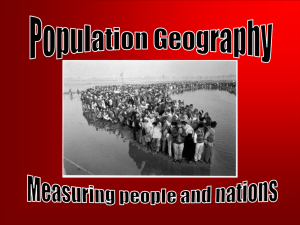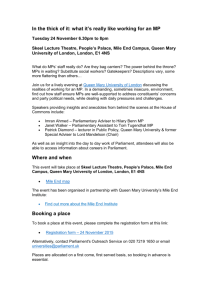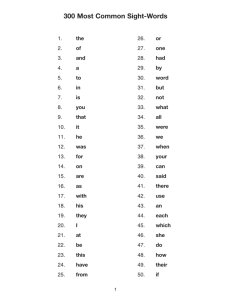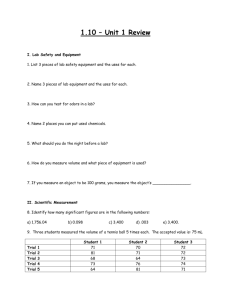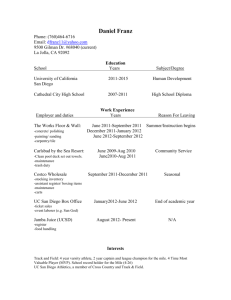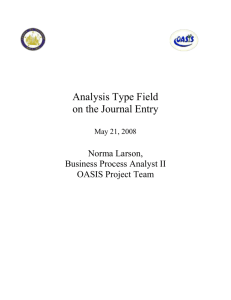Chapter 3 PowerPoints
advertisement
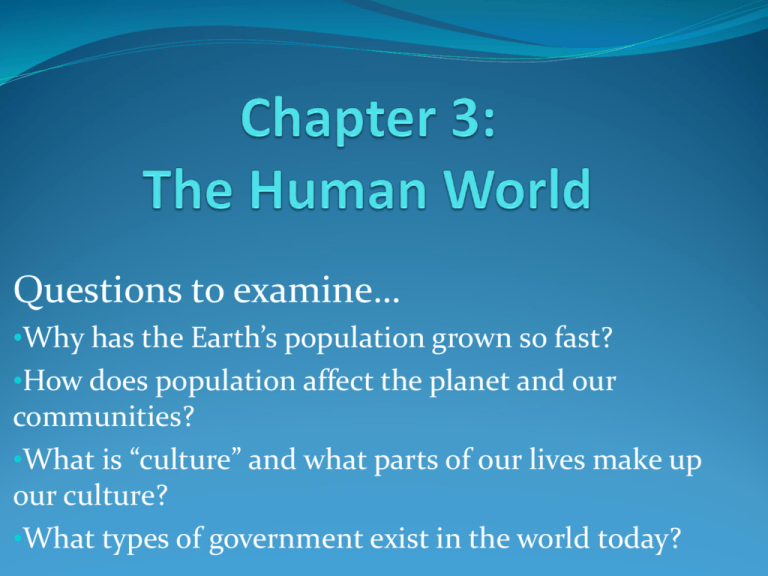
Questions to examine… •Why has the Earth’s population grown so fast? •How does population affect the planet and our communities? •What is “culture” and what parts of our lives make up our culture? •What types of government exist in the world today? Day 1 – Earth’s Population 500 AD – 190 million people on Earth 1000 – 265 million people on Earth 1500 – 425 million people on Earth 1800 – 860 million people on Earth 1900 – 1.7 billion people on Earth 2000 – 7 billion people 2050 – 9 million people? Population Population- the total number of people in a given area Population influences… Population Population has a huge impact on our lives! It is an important part of geography. Geographers study population to understand…. How many people live in an area Why people live where they do How populations change over time Examining Statistics 3 key things to learn about population changes: 1. Birth rate 2. Death rate 3. Rate of natural increase +/- Birthrate Birthrate- the annual number of births per 1,000 people. (US birth rate in 2013? 13.66 births/1,000 women) -Highest birth rates: Africa – Niger, Mali, Burkina Faso (Approx. 50 births/1,000) Death rate Death rate is the exact opposite of birthrate. -Annual number of deaths per 1,000 people Highest –South Africa – 17.3 deaths/1,000 (US- about 8.3 deaths/1,000 people) Natural Increase Formula Birthrate – Deathrate = Percentage of Natural Increase (US = .5%) (Niger = 3.6%) http://www.prb.org/DataFinder/Topic/Map.aspx?ind=16&fm t=16&tf=3&loc=249,250,251,252,253,254,34227,255,257,258,25 9,260,261,262,263,264,265,266,267,268,269,270,271,272,274, 275,276,277,278,279,280,281,282,283,284,285,286,287,288,28 9,290,291,292,294,295 Population Density Population density- A measure of the number of people living in an area. Formula for Population Density: Total Population Total Land Area ( sq.miles) Population Density Population density is measured in people per square mile or square kilometer. - More dense = more people = more heavily populated - Where do you think the most densely populated area in the world is? Population Density East China is the most densely populated area in the world Day 2 - Population Population Change Why would the study of population be important? Studying population is important because it affects housing, jobs, hospitals, schools, food Population Density Population density is measured in people per square mile or square kilometer. - More dense = more people = more heavily populated Population Density Japan (High Population Density) 880 people per square mile Mongolia (Low Population Density) 5 people per square mile Why Might an Area Not be Very Populated? Some areas aren’t very populated because… conditions are not favorable for living! Example: Greenland Parts of far North America Northern Asia Australia What do you think the population density is of the US? Find the Population Density of… The population density of the USA is 84 people/sq.mile 1. Australia Population = 20,264,082 Land Area = 2,941,283 2. Taiwan Population = 23,036,087 Land Area = 12,456 3. Rwanda Population = 8,648,248 Land Area = 9,633 Find the Population Density of… The population density of the USA is 84 people/sq.mile 1. Australia Population = 20,264,082 6.88 people/sq. mile Land Area = 2,941,283 2. Taiwan Population = 23,036,087 Land Area = 12,456 3. Rwanda Population = 8,648,248 Land Area = 9,633 1849.39 people/sq. mile 897.77 people/sq. mile People Explosion Why has Earth’s population exploded in the last 2oo years? Better health care/medicine Better sanitation Better food production Current Trend = growth in developing nations Population Changes Through… 1. Births 2. Deaths 3. Migration – people moving from one area to another Many people who migrate are refugees – people fleeing violence, warfare, or persecution Ex. – North Africans crossing Mediterranean - Syrians leaving Syria - Rohinga Muslims fleeing Myanmar More people = More problems Higher demand for energy Higher demand for water and food Higher demand for goods (cars, TVs, phones) Higher amount of pollution Lack of jobs Higher amount of poverty Higher amount of crime Over-crowding Disease spreads more easily Day 3 - Culture Culture Set of beliefs, values, and practices that a group of people has in common Culture includes many different aspects of life… Food Language Clothes Music Religion Arts/Sports What is American teenage culture? Cultural Trait An activity or behavior in which people often take part Local Global Culture Region Culture Region- an area in which people have many shared culture traits (religion, language, lifestyle) Are there cultural regions in the United States? Culture Regions in the US - Hawaii - The South - Rural America - Urban America - The Northeast - California - Southwest Cultural Diversity Ethnic group –a group of people who share a common culture and ancestry Cultural diversity- the state of having a variety of cultures in the same area Cultures with many different ethnic groups are culturally diverse. (this is the US!) Cultural Diversity Diversity can sometimes lead to conflict… -Rwanda: 1990s, Hutus & Tutsis -Yugoslavia: 1990s, Bosnians & Serbs -Syria: now, Sunni & Shi’a Muslims Cultures change constantly Two key causes: Innovation/Technology (cell phones, internet, TV, cars ) Contact with other people (Europeans get chocolate, tomatoes, and potatoes from the New World/Native Americans get coffee, horses, and pigs from Europe) Cultural Diffusion- the spread of culture traits from one region to another Day 4 – Types of Government Democracy Democracy-a form of government in which the power is held by the people elect leaders and rule by majority Representative Democracy – the people elect leaders to create, vote, and carry out laws Ex.: The United States Absolute Monarchy 1. Ruled by a king or queen 2. You are born into power (usually the next king or queen is the child of the king or queen) 3. People have little say in their goverment Ex.: King Salman of Saudi Arabia Constitutional Monarchy 1) King or queen is head of state, but very little power 2) Most have some sort of constitution 3) Most have an elected prime minister who is the real head of govt. Ex.: Queen Elizabeth II of Great Britain Ex.: Cuba and China Communism 1. Leaders are not elected by citizensare elected by a party 2. Government controls economy and daily life 3. People have very little freedom Dictatorship 1. Single powerful leader 2. Leader rules by force 3. People do not have freedom and have no say in government-lack of human rights Ex.: Kim Jong-Un of North Korea Anarchy Anarchy means there is no government Usually because previous government failed Rival groups will usually fight for power, very brief Day 5 – Economies of the World Resources: Meeting our Needs & Wants 3 Types of Resources: Natural Resources- resources from Earth Human Resources- labor, skills, talents of people Energy Resources- supplies that provide power to do work There is a limited supply & unlimited demand for resources!! Economy – system that determines ownership & distribution of resources Economies 3 Types: Traditional = people grow their own food and make their own goods (ex. Native Americans pre-Europeans) Market (most common) = based on private ownership, free trade, and competition, prices set by supply and demand (ex. USA/Canada/Germany) Command = central government makes all economic decisions (ex. Cuba) Mixed = part government and private (ex. China) Trade Trade – the business of buying, selling, or bartering Export – sell/send a product to another country Import – buying a product from another country Ex.: the USA imports oil from Nigeria the USA exports chicken to China Tariff – a tax added to the cost of a product, which is used to encourage people to buy goods made in their own country What might be advantages and disadvantages to trading? Interdependence Interdependence- a relationship between countries in which they rely on one another for resources, goods, or services Examples -Bananas from Ecuador -Tomatoes from Mexico Global Trade Organizations WTO- World Trade Organization IMF- International Monetary Fund World Bank NAFTA- North American Free Trade Agreement EU- European Union ASEAN- Association of Southeast Asian Nations TPP- Trans-Pacific Partnership Free Trade Agreement Globalization Globalization- the process in which countries are increasingly linked to each other through culture and trade Day 6 – How are Economies measured? Developed Countries Industrialized High literacy rates Access to medical care Jobs are available Longer life span Higher income Smaller families Ex. = USA, Germany, Japan, South Korea, Australia Developing Countries Agricultural More illiteracy Difficulty getting access to medical care Lack of jobs Shorter life span Poverty Larger Families Ex. = Rwanda, Mali, Laos, Pakistan, Kenya, Cuba Development in the world today… Standard of Living Standard of Living – the level at which a nation lives as measured by the extent to which its needs are met (Food, shelter, clothing, education, medical care) Citizens of a “developed” country have a higher standard of living Citizens of a “developing” country have a lower standard of living What is GDP? GDP = Gross Domestic Product used to measure the economy value of all goods & services produced within a country in a single year -Developed countries (USA/Germany)- have a high GDP. (about $17,000,000,000,000 in 2012) -Developing countries (Afghanistan)- have a lower GDP. (2/3 of world are “developing countries”)
